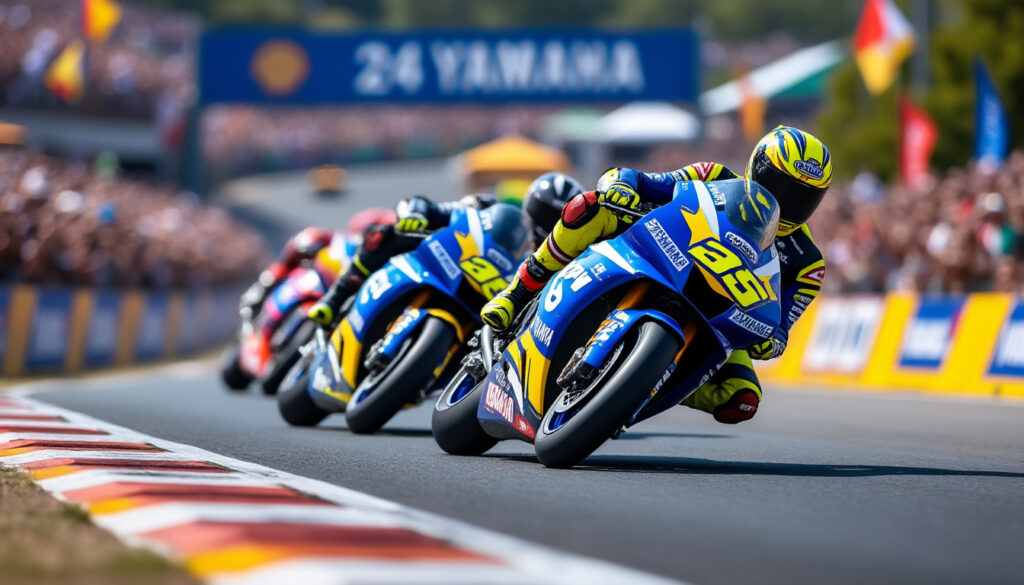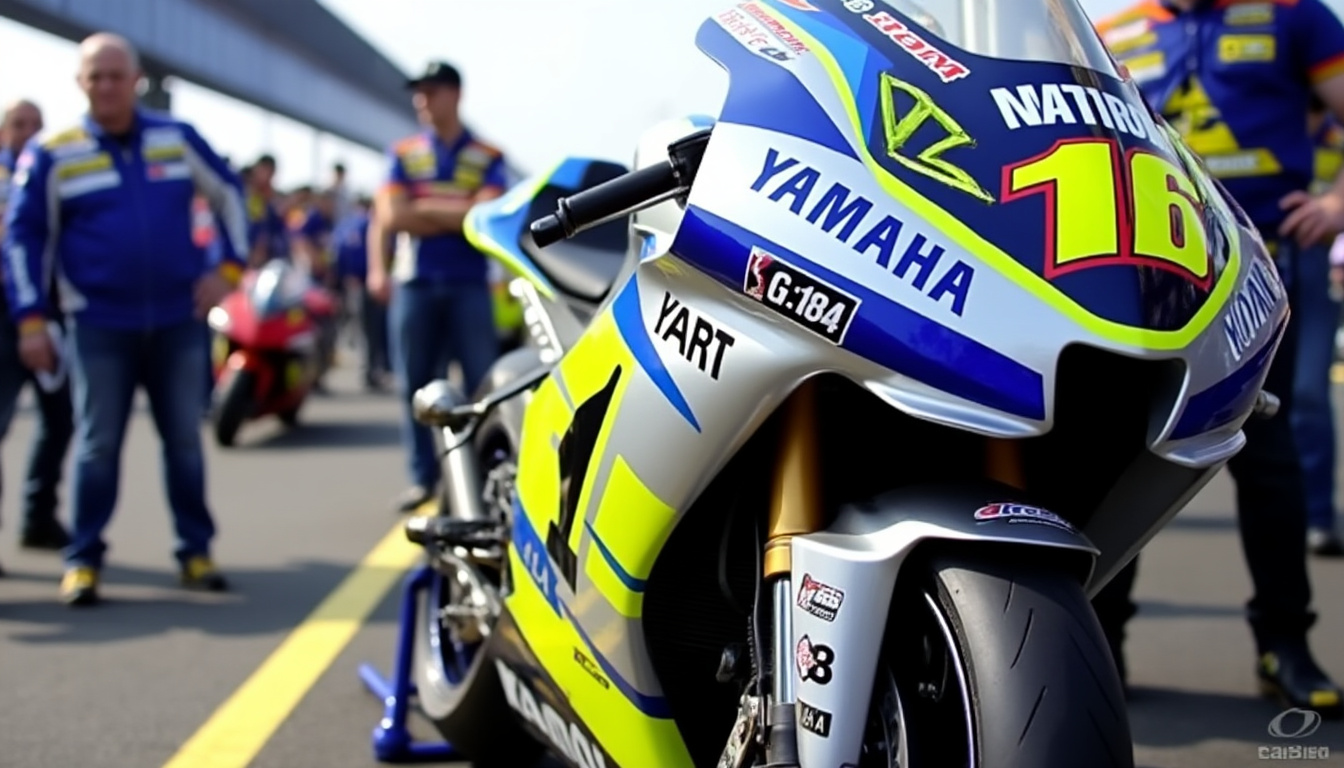YART Yamaha takes pole position at the 24H Motos

The 24H Motos, a major event in the motorcycle world, have once again captured the attention of speed and competition enthusiasts. For this 48th edition, which takes place on the Bugatti circuit in Le Mans, the YART Yamaha team distinguished itself by taking the pole position. This was achieved after dazzling qualifying sessions, marked by a new lap record set by Marvin Fritz. Other teams are also present, notably the Yoshimura SERT Motul, as the defending champions, as well as the Tati Team AVA6 Racing, which surprised by taking third place in qualifying. This article highlights the details of this thrilling competition, where the stakes are as diverse as they are exciting.
YART Yamaha, star of the qualifying sessions at the 24H Motos
This year, the YART Yamaha demonstrated exceptional performance during the sessions. By taking the pole position, the team showcased its ability to compete not only with other teams at its level but also with the giants of the sector. Marvin Fritz, at the helm of his Yamaha R1, was able to take advantage of the slipstream from Étienne Masson to achieve a remarkable time of 1'34.489, thereby breaking the previous lap record. This moment not only thrilled his teammates but also set a high standard for the rest of the competition.

Details of the qualifying sessions
The qualifying sessions were marked by palpable suspense. On the morning of the trials, Gregg Black, representing the Yoshimura SERT Motul team, made his mark by initially setting an impressive time of 1'34.551. However, the glory was short-lived, as Fritz quickly took over by improving the time by a few tenths. By the end of the qualifying sessions, the average of the two best times of each rider allowed the YART to take the lead with a collective performance of 1'34.664.
- 1st place : YART Yamaha - 01:34.664
- 2nd place : Yoshimura SERT Motul - 01:34.869
- 3rd place : Tati Team AVA6 Racing - 01:35.127
Performance analysis
The analysis of the qualifying times reveals tight contests among the top teams. Indeed, the Tati Team AVA6 Racing emerged in third place, which is a nice surprise and highlights the growing quality of this team. Other notable teams include the BMW Motorrad World Endurance Team and F.C.C. TSR Honda France, which showed solid potential but could not compete with the top three teams. The table below summarizes the qualifying results.
| Position | Team | Bike | Time |
|---|---|---|---|
| 1 | YART Yamaha | Yamaha R1 | 01:34.664 |
| 2 | Yoshimura SERT Motul | Suzuki GSX-R1000R | 01:34.869 |
| 3 | Tati Team AVA6 Racing | Honda CBR1000RR-R | 01:35.127 |
The challenge of endurance competition
The 24H Motos are much more than just a race; they represent a true test of endurance for both riders and machines. These races require not only incredible speed but also fine resource management and meticulous strategy. Balancing speed and durability is a major challenge that requires optimal teamwork. Every team member plays a crucial role in the final success.
The importance of strategy in endurance races
Strategy is also a critical aspect of the 24H Motos. Teams must anticipate track behavior and machine reactions based on various parameters, such as weather conditions. Climatic changes can heavily influence bike performance, requiring rapid adjustments. For example, this year, unstable weather forecasts added an extra layer of complexity to race management.
- Anticipation of pit stops: Refueling is crucial.
- Management of rider fatigue: Alternation takes into account long-term performance.
- Responsiveness to incidents: Pivoting in case of a fall or mechanical issue.
The technical challenges of the bikes
The bikes used in these competitions are the result of many years of research and development. The mechanics, which include advances in areas such as aerodynamics and braking systems, must be at the cutting edge of technology. The robustness of the machines is also tested, as the race lasts for 24 hours. The teams of mechanics play a leading role in orchestrating every intervention during the race.
| Technical Domain | Importance |
|---|---|
| Aerodynamics | Improves speed and stability on the track. |
| Braking System | Necessary for secure stops at high speeds. |
| Durability of components | Ensures proper functioning over the long term. |
The pillars of success: the riders
The riders play a predominant role in their team's success. Each of them must not only master driving techniques but also manage pressure and make quick decisions in the heat of the race. The duo of riders Marvin Fritz and Étienne Masson particularly stood out, with exemplary coordination and fluid communication. They were able to create a beautiful synergy, essential for achieving the pole position.
Rider profiles and their impacts
Each rider brings their own set of skills and experiences to the team. This enriches the group dynamic. Between managing fatigue symptoms and optimizing performance, complementarity plays a crucial role. Each rider must also be able to adapt to changing race conditions, a skill they specifically work on during training.
- Marvin Fritz: Speed management expert
- Étienne Masson: Specialist in delicate maneuvers
Training and mental preparation
A rider's preparation involves more than just physical and technical aspects of the race. Mental preparation also plays a significant role. Riders must be able to cope with extreme pressure, especially during critical moments of a 24-hour race. Thus, mental preparation sessions are an integral part of their routine. This allows them to stay focused and perform even in tense moments.
| Mental Preparation | Techniques Used |
|---|---|
| Visualization | Helps anticipate race reactions. |
| Meditation | Reduces stress before and during the race. |
| Breathing Exercises | Regulates heart rate in stressful situations. |
The mechanical challenges encountered during the 24H Motos
Technical and mechanical challenges are an integral part of the competition. Each team must be ready to face unforeseen obstacles, whether mechanical issues or race accidents. The ability to react quickly is a decisive asset to ensure performance continuity. Teams must possess both technical knowledge and a team philosophy to overcome these obstacles.
Management of breakdowns and interventions
In the event of a breakdown or technical issue, time is a critical factor. Teams must act quickly to address failures. Coordination between riders and mechanics is essential to ensure effective intervention. This involves clear communication and exemplary teamwork, where everyone knows exactly what they need to do during a pit stop.
- Rapid diagnosis of problems
- Effective intervention according to defined standards
- Anticipation of potential breakdowns during the race
Innovation at the service of performance
Innovative technologies play a prominent role in enhancing motorcycle performance. Teams regularly invest in new systems to ensure the safety and durability of machines. This includes advanced electronic systems, precise diagnostics, and high-quality spare parts. These innovations help riders achieve unprecedented performance levels.
| Innovation | Impact on Performance |
|---|---|
| Advanced Telemetry | Monitors real-time bike performance. |
| Advanced Braking Systems | Improved reaction in critical situations. |
| Lightweight Components | Improved maneuverability and speed. |
Source: www.lerepairedesmotards.com
Leave a Reply



Articles relatifs